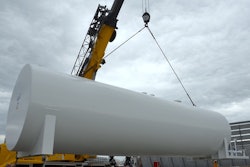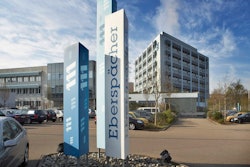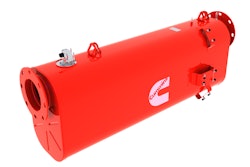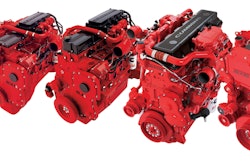Scania’s Transport Laboratory and the German transport company TSL have challenged each other: who can save the most fuel while transporting commercial cargo? Spectators may follow the deciding test on the web, with special insight into the positioning and fuel consumption of the two Euro 6 trucks provided by Scania Fleet Management.
“We run this challenge because we want to show the industry and the people concerned that it is possible to reach 25 litres/100 km in normal driving. All it takes is skilled drivers driving their vehicles with care,” says Anders Gustavsson, MD of Scania Transport Laboratory. “The majority of hauliers are often quite happy to reach a level around 31–32 litres/100 km. There’s absolutely no reason why we shouldn’t be able to do better.”
Klaus Ellinger, founder of TSL, explains that his company entered the challenge because “we know that we have really good drivers who know how to handle a truck. We see the resulting low consumption in our everyday business, as well as lower maintenance costs and improved service performance. Moreover, our drivers are dependable; they treat the trucks with respect and make optimum use of them.”
The challenge between Hanna Fange from the Scania Transport Laboratory and Peter Röder from TSL begins at 04:00 Thursday 26 May at Scania’s production unit in Södertälje, Sweden. That’s when the two Scania R 480 two-axle tractors with Euro 6 engines (totaling 40 tons of gross weight) will leave on their journey from Södertälje to Scania’s production unit in Zwolle, the Netherlands. The trucks travel south through Sweden and Denmark to Vordingborg, approximately 100 kilometers south of Copenhagen, Denmark. There the drivers will take their statutory rest period of eleven hours. In the meantime, the trucks will continue to Zwolle with other drivers. At 02:00 on Friday 27 May the challenge will resume with Hanna Fange and Peter Röder at the wheels as two new trucks from Zwolle, with the exact specifications as their previous vehicles, leave Vordingborg to reach Södertälje around 13:00.
Spectators may follow the challenge on the web, where data from the Scania Fleet Management will be published; among other features, the system displays information about each truck’s position and fuel consumption. Visit www.scania.com/fuelduel for more information.
Scania Fleet Management enables transport companies to keep better track of vehicles and drivers, thereby improving the efficiency of their fleets. The system is based on a little “black box” called the Scania Communicator, which is installed on the truck and automatically gathers information from the vehicle, such as fuel consumption, driving style and braking behaviour. This information is then transmitted wirelessly to the office along with GPS positioning data.
With the help of this system, operators can keep track of exactly where their vehicles are, their fuel consumption, how they are being driven and when it is time for the next service. They can then use this information to improve their profitability and reduce their environmental impact.
TSL is a German transport company that specialises in time-critical deliveries for the food industry. Established in 1994, the company is based in Groß-Umstadt, near Frankfurt am Main in Germany, and has 60 employees. The fleet comprises 37 of the company’s own tractors as well as an additional hundred or so vehicles provided by contracted suppliers. TSL invests significant resources in fuel efficiency, providing regular training and follow-up for its drivers to ensure that they drive economically.
The Scania Transport Laboratory is a wholly owned subsidiary of Scania that tests and evaluates vehicle characteristics and performance in commercial road haulage. The company’s tasks also include training and coaching its drivers in economical and safe driving techniques. The company accounts for a small portion of the goods haulage between Scania’s European production and assembly units. Its fleet consists of 20 tractor units and about 70 semitrailers.



















